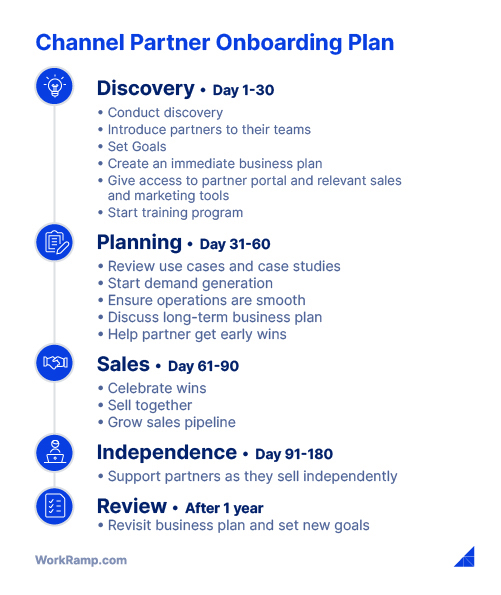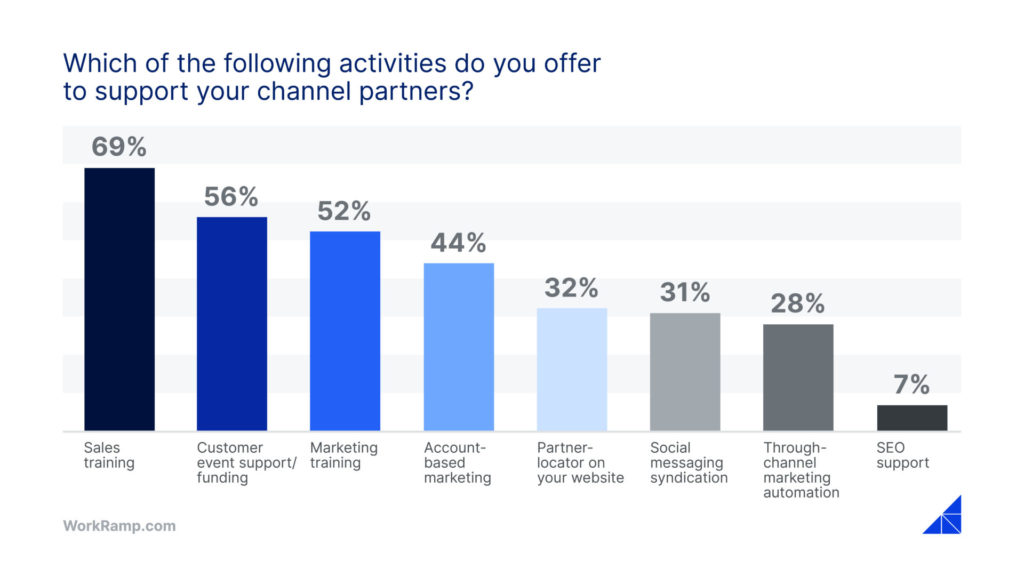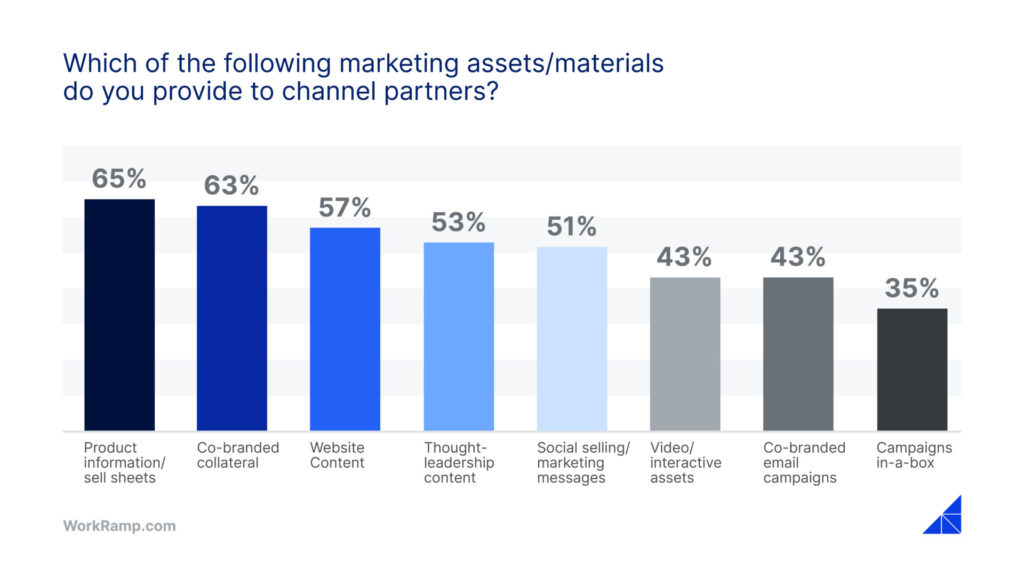5 Tips for Building a Partnership Enablement Framework
Michael Keenan | WorkRamp Contributor
View bioLearning Tips Straight to Your Inbox
To say partnership enablement has boomed is an understatement. In 2022, 96 percent of company executives and channel leaders expect their partner ecosystems to increase revenue directly. Plus, 82 percent of channel marketers plan to increase the number of partner sellers in their ecosystem this year.
Integrating partners into your sales process can help you enter new markets quickly and grow your leads year over year. As a result, mid-sized to enterprise organizations typically work with around 155 channel and reseller partners at one time.
At this scale, recruiting, training, and managing partners must be a reliable, repeatable process. Here are some tips to help you build an effective partnership enablement framework.
In this post:
1. Invest in a learning management system (LMS)
Creating a partnership enablement framework begins long before onboarding partners and aligning on goals. First, consider whether you should invest in an LMS to support partner training and communication assets. As with internal employees, channel partners prefer learning content they can apply immediately.
Recent survey results show that 53 percent of partners believe current vendor content is mediocre or worse. However, 75 percent of them rated content as important. According to another study, 65 percent of channel partners think vendor content is poor or inaccessible.
If you are developing a partnership enablement framework, consider how you will enable people to learn and sell. Partner revenue represents a significant portion of company revenue, sometimes as high as 50 percent. A solid learning management system is critical to educating, certifying, and training your partners on your products, which is why 54 percent of organizations use one.
Organizing and coordinating training within a flexible learning management system allows organizations to educate their partners more effectively and increase market penetration in a more cost-effective, consistent way.
An LMS offers the following advantages over classroom-based learning:
- Reduce training time. Online, asynchronous training is available to partners anywhere.
- Less expensive. Bring classes online to eliminate instructor, travel, and venue costs. Training is free for everyone.
- Standardized instruction. Training consistency across your partner network will ensure that everyone receives the same, high-quality courses and tools.
Managing partner channels can be difficult and expensive, especially when you have a global network. An LMS allows you to design, manage, and deliver training to partners so that your program is a success.
“I honestly can’t imagine doing my job and my role effectively without WorkRamp,” says Chauncy Cay Ford, Director of Enablement at Quantum Metrics. “It’s just part of the DNA of our enablement charter, and the tool that helps us drive this engine. To me, WorkRamp is not a ‘sell-you, get you onboarded, and leave you. WorkRamp truly wants to partner with you and make sure that you continue to be successful. It’s an ongoing relationship and that’s not something all software companies have to do–so I appreciate that.
“When I evaluated Learning Management System options, I prioritized ease of use. With some platforms, there’s an element of having to learn the system itself.
“We wanted to make sure that our partners and employees were able to focus on learning content, not learning how to navigate our LMS. WorkRamp did that for us. It gave us a platform that was accessible for our entire audience.”
2. Put a thorough onboarding process in place
Have you decided on an LMS for your organization? Developing a robust onboarding program is the next step in creating a partner enablement framework. This is arguably the most important step.
A well-executed channel partner onboarding:
- Introduces partners to your brand
- Encourages partners who realize your value proposition to do business independently
- Provides a quicker time to value and ROI
- Reduces churn and increases partner loyalty
- Streamlines recruiting by leveraging partner advocacy
Seventy-three percent of partners cite too much complexity in vendor channel programs. An effective onboarding process can ease this burden. Demonstrate to partners the value of the training, tools, and program they will use. By showing them how to complete and use the program, engagement will increase.
Onboarding is only successful if you plan ahead. Onboarding for the first 90 days is recommended in the Channel Company’s IPED Consulting and Research division’s onboarding guide. A longer onboarding period may have a significant impact on a vendor’s productivity.
Here is an example of an onboarding plan you might use.

Setting goals and expectations for partners is critical from the beginning. To increase their chances of achieving their goals, describe what you expect them to accomplish. Assess where your partner has weaknesses you can help with, and check-in with them regularly to see how they are progressing. Your partnership program should be ongoing, your LMS should act as a pulse that allows you to stay connected to your partners throughout the onboarding process and beyond.
Once you and your partner can align on the goal and strategy, you will both be able to thrive and innovate.
3. Provide sales training
An organization cannot provide one-time training and expect partners to excel. Among organizations offering channel partner support, 69 percent provide sales training, and 52 percent provide marketing training.

Providing partners with sales training increases the value of the partnership and the bond between companies. Most importantly, when an organization takes the time to train their partners on their “secret sauce,” it creates a common brand in the market, and no matter who a prospect is working with, they get a similar sales approach and experience.
But partners don’t always have the sales materials they need to succeed. In one study, 84 percent of the partners said they had no dedicated marketing resource in their program. Training and case studies that demonstrate these tactics can help partners feel more confident and sell more.
Be sure to include the following in your training:
- The problem your product or service solves
- Value propositions and core discovery techniques
- Niches where it sells well
- Why your product is top-tier in the market
- Current partner SPIFFs and incentives
- Customer promotions
- How to get closing support
Not all people learn and digest information in the same way. Be sure to keep this in mind when designing your sales and marketing training.
Although we’re in a business setting, our partners need inspiration and excitement too. Currently, less than 15 percent of partners participate in marketing programs vendors deliver. Adding gamification and certifications to recognize completion and high performance can help partners retain and apply knowledge, which will help your organization sell more.
4. Provide necessary marketing tools and training
Providing partners with the necessary marketing tools is a must for every organization. By giving them marketing collateral, they can present a professional image and close more sales. You will also ensure they comply with your brand guidelines.
What materials should you give your partners? According to DemandGen Reports 2022 Channel/Partner Marketing Benchmark Survey, respondents provided channel partners with the following assets:
- Production information/sell sheets (65%)
- Co-branded collateral (63%)
- Website content (57%)
- Thought-leadership content (53%)
- Social selling/marketing messages (51%)
- Video/interactive assets (43%)
- Co-branded email campaigns (43%)
- Campaigns-in-a-box (35%)

Adapting assets to meet your partner’s needs is also important. In one survey, 33 percent of partners said that customized assets were more important than datasheets, infographics, and other content like whitepapers.
Perhaps your partner doesn’t need the assets mentioned above. There are other options such as:
- Call scripts
- Pitch decks
- Lead magnets
- Email drip campaigns
- Ad templates
- Newsletter templates
How far your partners take your program determines its success. Make sure they have the best marketing and sales tools so they can do their job well.
5. Communicate with partners regularly
Partners are your best friends. They understand your products and services and want to help you sell them. It can be difficult to keep partners updated, but a good communication plan shows your commitment to their success.
Communication with partners will be essential for:
- Product updates
- Training opportunities
- Re-certifications
- Events
- Contests
- SPIFFs
- Commission distributions
- New promotions
You don’t have to reinvent the wheel either. In the DemandGen Reports 2022 survey, B2B leaders were also asked about their partner communication channels. The top channels were:
- Email (79%)
- Online meetings (63%)
- In-person events (52%)
- Partner portal (52%)
- Outreach by account manager (49%)
- Regularly scheduled newsletter (36%)
- Partner surveys (28%)
- Online community (21%)
Remember that your partners also work with other companies. Respect their time and needs, and aim to become the easiest organization to work with. You want to be top of mind for your partner so that when given the opportunity to position a product, they pitch yours first.
Here are a few tips for communicating with partners:
- All communications should be timely, relevant, and helpful
- Partners should have easy access to information
- Customize materials and training where possible to fit the specific needs of your partner
- Make sure messages are tailored to different roles
- Provide enablement resources where partners expect to find them
- Clearly communicate progress and lead status updates
Two-way communication is essential. Communicate with partners so that they feel comfortable responding. By fostering an open and safe environment, you can get real-time feedback. A good partner program incorporates a healthy feedback loop about your products and the effectiveness of your training.
Build your partnership enablement framework today
About 62 percent of companies believe partner programs add great value to their marketing strategies. Establish a framework that allows you to train and manage partners reliably in order to support partner growth. If you follow the tips above, you can build out your partnership enablement framework with confidence and profit from the revenue boost that partner programs provide.
WorkRamp can help you equip your partners with the sales enablement tools and training they need to succeed. Request a demo to learn more.
Complete the form for a custom demo.
Recent Posts
- Onboarding with an LMS: How to Set New Hires Up for Success July 16, 2025
- Why Secure LMS Platforms Are a Must for Regulated Industries July 10, 2025
- Top LMS Integrations That Power Smarter, Faster Learning July 2, 2025
- Introducing WorkRamp Analytics Studio: Unlocking Your Data Insights with AI June 30, 2025
- 11 AI LMS for AI-Powered Learning June 27, 2025
Michael Keenan
WorkRamp ContributorMichael is a SaaS marketer living in Guadalajara, Mexico. Through storytelling and data-driven content, his focus is providing valuable insight and advice on issues that prospects and customers care most about. He’s inspired by learning people’s stories, climbing mountains, and traveling with his partner and Xoloitzcuintles.
You might also like
3 essential sales enablement tools
Too many tools can be distracting for reps. Here are the enablement tools you really need to achieve sales goals.
Read More
Why Enablement Should Be at the Executive Table
Enablement is critical to the success of your organization. In fact, research shows that organizations with a sales enablement function have way higher win rates than organizations that don’t. So why don’t we always have a seat at the executive table?
Read More
10 Tips for Executing a Successful Virtual Sales Kickoff (SKO)
Celine Grey, who leads Global Sales Enablement at Peakon, a Workday company, shares 10 tips for planning a successful virtual Sales Kickoff (SKO).
Read More
Decrease Ramp Time and Increase Revenue
Get in touch to learn how WorkRamp can help you achieve your learning and development goals.
Request a Demo




